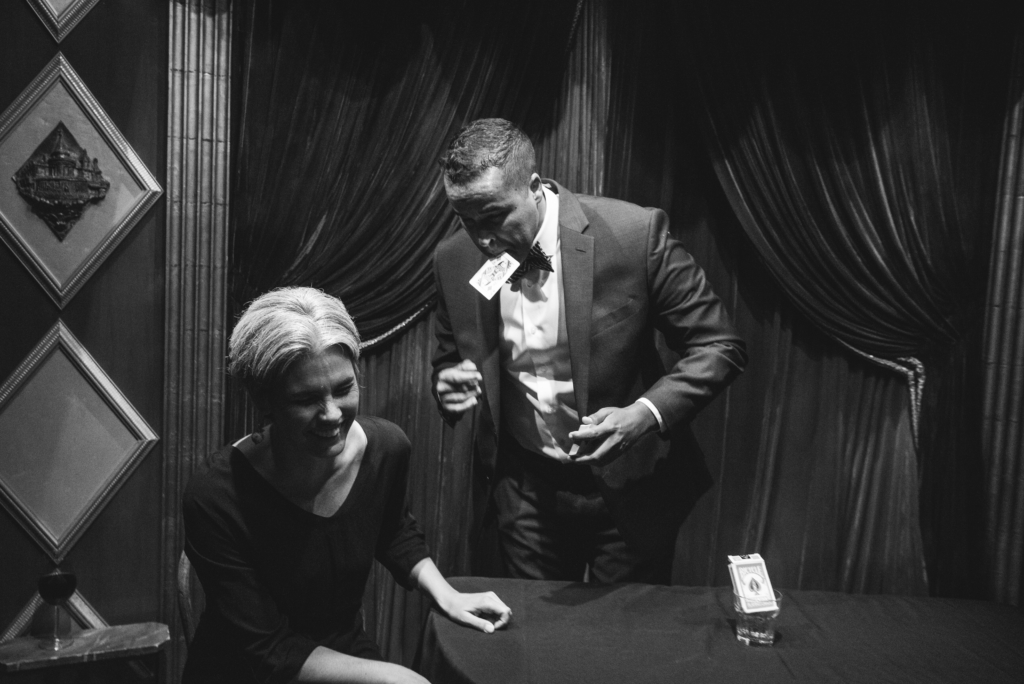
While there are a seemingly infinite number of magic tricks in the world, there are a few main types of performances that most tricks fall under. Understanding these basic terms and types can help you get to know the world of magic or start creating your own tricks.
The scale of magic
What is magic without a stage? Magic has its own scale, from individual performances to grand shows.
Close-up magic
Close-up magic is a more intimate performance. It typically involves an audience of only a few people, sometimes just one.
Parlor magic
Parlor magic is a classic term. It means magic performed for an audience bigger than just a few people, but still smaller than a large auditorium.
Stage magic or stage illusions
These are performances on a large scale, such as for an entire auditorium of theater of people.
Categories of magic
While no two magicians are the same, many operate within similar categories based on the effects the trick creates.
Vanishing
Vanishing is one of the basic forms of magic, in which the magician makes an object disappear, such as a coin or card. Sometimes magicians can make very large objects disappear, such as cars or even humans.
Production
Production is the opposite of vanishing. This is when a magician causes something to appear out of nothing. The classic example is a magician who can pull a rabbit out of his empty hat. More practiced magicians may be able to conjure up more difficult objects, seemingly out of thin air.
Escape
Escape specialists such as the classic example, Houdini, astound audiences with their ability to get out of situations in which they are trapped. This may be “simply” escaping from a straight jacket, or more extreme stunts such as escaping from a body bag being lowered into a shark tank.
Transposition
Transposition artists wow audiences with their ability to make two or more objects change places at will. Different cards may appear in someone’s hand, drinks may change places, or any number of other magical swaps.
Transformation
As it sounds, transformation magic involves turning one thing into another, such as a wand turning into a bouquet of flowers or changing an egg into a bird.
Penetration
For penetration magic, a magician passes one solid object through another. This may include passing an object through a wall or into a box. It may also include more difficult acts, such as passing swords through an audience member.
Prediction
Prediction magic can make a magician seem like a mind reader. The magician correctly predicts the outcome of an event, such as the answer an audience member will select or the amount of money in a person’s wallet.
Restoration
After destroying an object, such as a card, coin, or drawing, the magician is able to restore it to it’s original shape instantly, amazing audiences and defying logic.
Levitation
Defying the laws of nature is all in a day’s work for a magician. Levitation magicians cause objects to levitate, defying gravity without the aid of outside tools.
Genres of magic
Magic can also be divided by genre, though a performer may fall into any different number of magic genres, and may use different types of magic.
Street magic
Street magic is an upfront performance, made popular by magicians such as David Blaine. Magicians perform magic on unsuspecting people in public rather than audience members.
Pickpocket
Pickpocket magic involves using misdirection to remove personal effects from audience members. This is often done in small settings, such as one on one or in small rooms.
Escapology
Escapology as a craft mainly focuses on various forms of escapism, from handcuffs and straight jackets to water tanks and even railroad tracks.
Mentalism
A mentalist can make people believe they have special powers, such as the ability to read minds or predict events.
Shock magic
Shock magic intends to add shock value to the show to keep the audience on the edge of their seats. This may include stunts such as eating glass or piercing the body with needles.
Bizarre magic
Bizarre magic may incorporate aspects of fantasy, horror, and circus to the magic show. They may have the added effect of scaring or shocking audience members while also wowing them.
Computer magic
Recently a number of computer magic styles have appeared, where an algorithm creates the magic rather than a magician. From card tricks to number guessing, computer magic covers a lot of topics
These are the basic forms magic takes. How each magician expresses their style within these forms will be different, and some of the best magicians incorporate elements of each style into their act.
